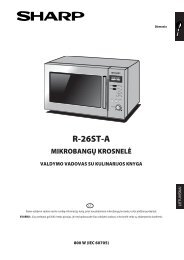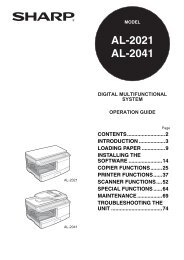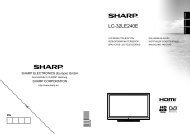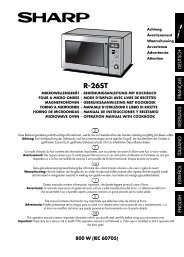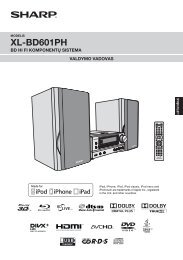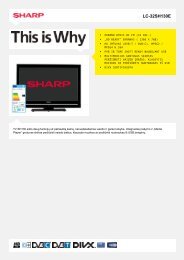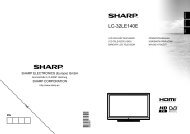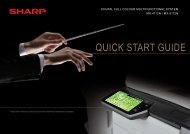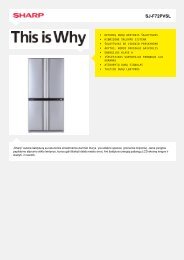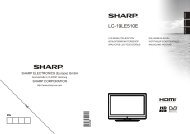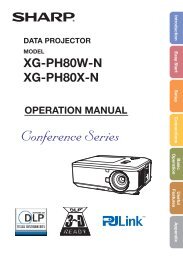R-879 Operation-Manual GB - Sharp
R-879 Operation-Manual GB - Sharp
R-879 Operation-Manual GB - Sharp
You also want an ePaper? Increase the reach of your titles
YUMPU automatically turns print PDFs into web optimized ePapers that Google loves.
R-<strong>879</strong>_[EN].qxd 6/4/07 3:58 PM Page 1<br />
IMPORTANT SAFETY INSTRUCTIONS<br />
IMPORTANT SAFETY INSTRUCTIONS: READ CAREFULLY AND KEEP FOR FUTURE REFERENCE<br />
To avoid the danger of fire.<br />
The microwave oven should not be left<br />
unattended during operation. Power<br />
levels that are too high, or cooking times<br />
that are too long, may overheat foods<br />
resulting in a fire.<br />
This oven is designed for counter top or built-in use.<br />
Do not place the oven in a cabinet. When the oven is<br />
to be built-in, the installation frame EBR-5000 licensed<br />
by SHARP must be used. This is available from your<br />
dealer. Refer to the frame installation instructions or ask<br />
your dealer for the proper instruction procedure. Only<br />
the use of this frame will guarantee the safety and<br />
quality of the product.<br />
The electrical outlet must be readily accessible so that<br />
the unit can be unplugged easily in an emergency.<br />
The AC power supply must be 230V, 50Hz, with a<br />
minimum 16A distribution line fuse, or a minimum 16A<br />
distribution circuit breaker.<br />
A separate circuit serving only this appliance should be<br />
provided.<br />
Do not place the oven in areas where heat is<br />
generated. For example, close to a conventional oven.<br />
Do not install the oven in an area of high humidity or<br />
where moisture may collect.<br />
Do not store or use the oven outdoors.<br />
If smoke is observed, switch off or<br />
unplug the oven and keep the door<br />
closed in order to stifle any flames.<br />
Utensils should be checked to ensure that<br />
they are suitable for use in the oven. See<br />
Page <strong>GB</strong>-XX-XX. Use only microwave<br />
safe containers and utensils on<br />
microwave modes.<br />
When heating food in plastic or paper<br />
containers, keep an eye on the oven due<br />
to the possibility of ignition.<br />
Clean the waveguide cover, the oven<br />
cavity and the turntable after use. These<br />
must be dry and free from grease. Builtup<br />
grease may overheat and begin to<br />
smoke or catch fire.<br />
Do not place flammable materials near the oven or<br />
ventilation openings.<br />
Do not block the ventilation openings.<br />
Remove all metallic seals, wire twists, etc., from food<br />
and food packages. Arcing on metallic surfaces may<br />
cause a fire.<br />
Do not use the microwave oven to heat oil for deep<br />
frying. The temperature cannot be controlled and the<br />
oil may catch fire.<br />
To make popcorn, use only special microwave<br />
popcorn makers.<br />
Do not store food or any other items inside the oven.<br />
Check the settings after you start the oven to ensure the<br />
oven is operating as desired.<br />
<strong>GB</strong>-1<br />
To avoid overheating and fire, special care must be taken when<br />
cooking or reheating foods with a high sugar or fat content, for<br />
example, Sausage rolls, Pies or Christmas pudding.<br />
See the corresponding hints in operation manual and the<br />
cookery book section.<br />
To avoid the possibility of injury<br />
WARNING:<br />
Do not operate the oven if it is damaged or<br />
malfunctioning. Check the following before use:<br />
a)The door; make sure the door closes properly and<br />
ensure it is not misaligned or warped.<br />
b)The hinges and safety door latches; check to make sure<br />
they are not broken or loose.<br />
c) The door seals and sealing surfaces; ensure that they<br />
have not been damaged.<br />
d)Inside the oven cavity or on the door; make sure there<br />
are no dents.<br />
e) The power supply cord and plug; ensure that they are<br />
not damaged.<br />
If the door or door seals are damaged, the oven must not be<br />
operated until it has been repaired by a competent person.<br />
Never adjust , repair or modify the oven yourself.<br />
It is hazardous for anyone other than a competent<br />
person to carry out any service or repair<br />
operation which involves the removal of a cover<br />
which gives protection against exposure to<br />
microwave energy.<br />
Do not operate the oven with the door open or<br />
alter the door safety latches in any way.<br />
Do not operate the oven if there is an object<br />
between the door seals and sealing surfaces.<br />
Do not allow grease or dirt to build up on the<br />
door seals and adjacent parts. Clean the oven<br />
at regular intervals and remove any food<br />
deposits. Follow the instructions for “Care and<br />
Cleaning” on page <strong>GB</strong>-24. Failure to maintain<br />
the oven in a clean condition could lead to a<br />
deterioration of the surface that could<br />
adversely affect the life of the appliance and<br />
possibly result in a hazardous situation.<br />
Individuals with PACEMAKERS should check with<br />
their doctor or the manufacturer of the pacemaker<br />
for precautions regarding microwave ovens.<br />
To avoid the possibility of electric shock<br />
Under no circumstances should you remove the outer cabinet.<br />
Never spill or insert any objects into the door lock openings or<br />
ventilation openings. In the event of a spill, turn off and unplug the<br />
oven immediately, and call an authorised SHARP service agent.<br />
Do not immerse the power supply cord or plug in<br />
water or any other liquid.<br />
Do not let the power supply cord hang over the<br />
edge of a table or work surface.<br />
ENGLISH



